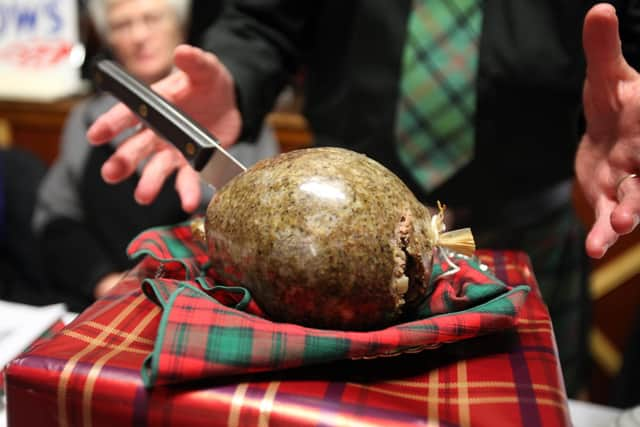Paula McIntyre: Many butchers will do all the hard work for you and make you a haggis
and live on Freeview channel 276
Burns was born fortuitously on January 25th, 1759 and Scottish or not his arrival in the world is an excuse to liven up a potentially dreich January day.
The first Burn’s supper was held at the family cottage, in the village of Alloway near Ayr, by Burns’s friends, on 21 July 1801, the fifth anniversary of his death. It has been a regular occurrence ever since across the globe.
Advertisement
Advertisement
At the centre of any Burn’s night supper is the Haggis. You could make your own Haggis if you want by boiling lamb’s pluck heart, lungs and liver, chopping it and mixing it with oats, suet and spices. Press this mixture into an ox stomach lining, tie and simmer for a couple of hours. Don’t fancy this? There are many butchers in Northern Ireland who will do all the hard work for you. Tom’s butchers in Portstewart make them every year and they’re as good as anything you can get in Scotland. Haggis is in no way a luxury item – it was borne out of the necessity to use the readily available cheaper cuts and offal. Something that still makes a lot of sense. My first recipe uses haggis in a Wellington with mushrooms and a whiskey sauce. I’ve included the recipe for flaky pastry but feel free to use ready made puff. Serve on their own or with some mashed turnip and potatoes, “neeps and tatties”. Last year I filmed a Burns night banquet at Montalto Estate outside Ballynahinch. The programme is on BBC Iplayer until Monday night if you want some more inspiration for your supper. Pour yourself a wee whiskey and toast the bard with “Fairfa’ your honest, sonsie face, Great chieftain o’ the pudding-race!”


Another Celtic celebration on the 25th January is St Dwynwen’s Day. St Dwynwen is the Welsh patron saint of lovers, who lived during the fifth century. She fell in love with a prince called MaelonDafodrill but her father had arranged for her to marry someone else. She was so upset she begged God to make her forget him. After falling asleep she was visited by an angel, carrying a sweet potion designed to erase the memory of Maelon and turn him into a block of ice. God then gave Maelon three wishes. Her first wish was that Maelon would be thawed; her second that God would meet the hopes and dreams of true lovers; and the third that she would never marry. All three were fulfilled and Dwynwen devoted herself to God’s service for the rest of her life. She founded a convent in Llanddwyn, off the coast of Anglesey, where a well named after her death in 465AD became a place of pilgrimage. The popularity and celebration of St Dwynwen’s Day has increased in recent years.
Welsh cakes are like a scone that’s cooked on a griddle. It’s a simple recipe of buttery dough, studded with currants and cooked like a soda farl. They’re dusted with a little sugar while hot and eaten straight away. You could serve them with a dollop of cream and jam too.
Scottish poetry, haggis, some Welsh love and a buttery cake – how could that not brighten up a dull January day?